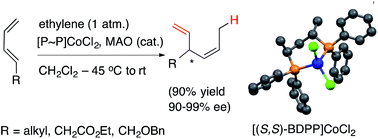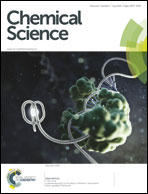Cobalt-catalysed asymmetric hydrovinylation of 1,3-dienes†
Abstract
In the presence of bidentate 1,n-bis-diphenylphosphinoalkane-CoCl2 complexes {Cl2Co[P ∼ P]} and Me3Al or methylaluminoxane, acyclic (E)-1,3-dienes react with ethylene (1 atmosphere) to give excellent yields of hydrovinylation products. The regioselectivity (1,4- or 1,2-addition) and the alkene configuration (E- or Z-) of the resulting product depend on the nature of the ligand and temperature at which the reaction is carried out. Cobalt(II)-complexes of 1,1-diphenylphosphinomethane and similar ligands with narrow bite angles give mostly 1,2-addition, retaining the E-geometry of the original diene. Complexes of most other ligands at low temperature (−40 °C) give almost exclusively a single branched product, (Z)-3-alkylhexa-1,4-diene, which arises from a 1,4-hydrovinylation reaction. A minor product is the linear adduct, a 6-alkyl-hexa-1,4-diene, also arising from a 1,4-addition of ethylene. As the temperature is increased, a higher proportion of the major branched-1,4-adduct appears as the (E)-isomer. The unexpectedly high selectivity seen in the Co-catalysed reaction as compared to the corresponding Ni-catalysed reaction can be rationalized by invoking the intermediacy of an η4-[(diene)[P ∼ P]CoH]+-complex and its subsequent reactions. The enhanced reactivity of terminal E-1,3-dienes over the corresponding Z-dienes can also be explained on the basis of the ease of formation of this η4-complex in the former case. The lack of reactivity of the X2Co(dppb) (X = Cl, Br) complexes in the presence of Zn/ZnI2 makes the Me3Al-mediated reaction different from the previously reported hydroalkenylation of dienes. Electron-rich phospholanes, bis-oxazolines and N-heterocyclic carbenes appear to be poor ligands for the Co(II)-catalysed hydrovinylation of 1,3-dienes. An extensive survey of chiral ligands reveals that complexes of DIOP, BDPP and Josiphos ligands are quite effective for these reactions even at −45 °C and enantioselectivities in the range of 90–99% ee can be realized for a variety of 1,3-dienes. Cobalt(II)-complex of an electron-deficient Josiphos ligand is especially active, requiring only <1 mol% catalyst to effect the reactions.


 Please wait while we load your content...
Please wait while we load your content...